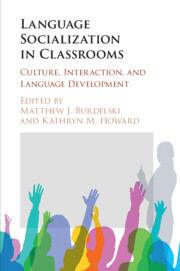Book contents
- Language Socialization in Classrooms
- Language Socialization in Classrooms
- Copyright page
- Dedication
- Contents
- Figures
- Tables
- Contributors
- Acknowledgments
- Transcription Conventions
- 1 Introduction
- Part I Socializing Values, Dispositions, and Stances
- Part II Socializing Identities
- Part III Language Socialization and Ideology
- Part IV Conclusion
- Index
- References
1 - Introduction
Language Socialization in Classrooms
Published online by Cambridge University Press: 10 February 2020
- Language Socialization in Classrooms
- Language Socialization in Classrooms
- Copyright page
- Dedication
- Contents
- Figures
- Tables
- Contributors
- Acknowledgments
- Transcription Conventions
- 1 Introduction
- Part I Socializing Values, Dispositions, and Stances
- Part II Socializing Identities
- Part III Language Socialization and Ideology
- Part IV Conclusion
- Index
- References
Summary
This chapter details how language socialization (LS) research has contributed to our understanding oflearning in classrooms. It describes the methodological and theoretical frameworks that underlie LS theory. It outlines five areas of LS and describes how they relate to classroom discourse: (1) indexicality, (2) practices, (3) ideologies, (4) power, authority, and agency, and (5) participation frameworks. It argues that the LS paradigm provides a unique and specific set of affordances for exploring the social and linguistic development of relative novices and theirlearning in classrooms involving teachers and peers. It asserts that LS theory and research contribute rich and socially situated understandings of children’s and other novices’ social worlds, their linguistic and social development, the interactions and learning modes that foster this development, and the broader fields of discourse, histories, and communities within which classrooms are situated. The chapter includes an overview of each section and its goals, explaining how each contribution instantiates the LS framework in ways that deepen our understanding of learning and development within classrooms.
- Type
- Chapter
- Information
- Language Socialization in ClassroomsCulture, Interaction, and Language Development, pp. 1 - 26Publisher: Cambridge University PressPrint publication year: 2020
References
- 3
- Cited by

